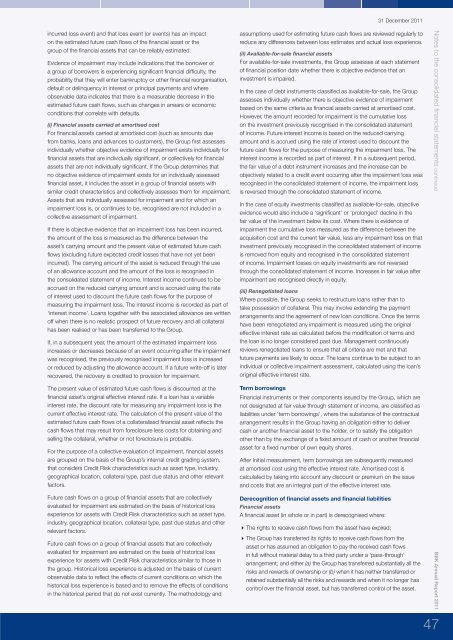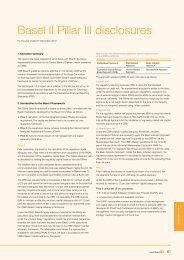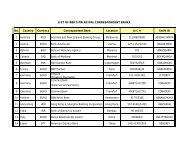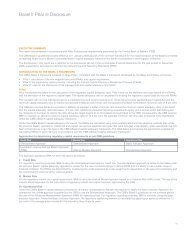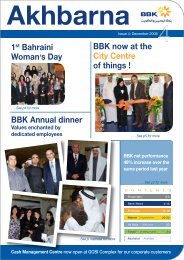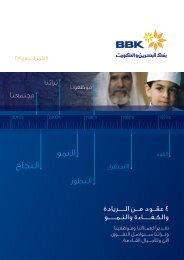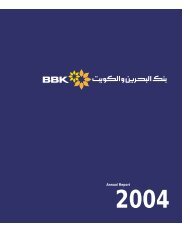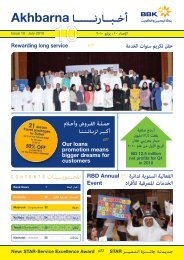BBK Annual Report 2011
BBK Annual Report 2011
BBK Annual Report 2011
Create successful ePaper yourself
Turn your PDF publications into a flip-book with our unique Google optimized e-Paper software.
31 December <strong>2011</strong>incurred loss event) and that loss event (or events) has an impacton the estimated future cash flows of the financial asset or thegroup of the financial assets that can be reliably estimated.Evidence of impairment may include indications that the borrower ora group of borrowers is experiencing significant financial difficulty, theprobability that they will enter bankruptcy or other financial reorganisation,default or delinquency in interest or principal payments and whereobservable data indicates that there is a measurable decrease in theestimated future cash flows, such as changes in arrears or economicconditions that correlate with defaults.(i) Financial assets carried at amortised costFor financial assets carried at amortised cost (such as amounts duefrom banks, loans and advances to customers), the Group first assessesindividually whether objective evidence of impairment exists individually forfinancial assets that are individually significant, or collectively for financialassets that are not individually significant. If the Group determines thatno objective evidence of impairment exists for an individually assessedfinancial asset, it includes the asset in a group of financial assets withsimilar credit characteristics and collectively assesses them for impairment.Assets that are individually assessed for impairment and for which animpairment loss is, or continues to be, recognised are not included in acollective assessment of impairment.If there is objective evidence that an impairment loss has been incurred,the amount of the loss is measured as the difference between theasset’s carrying amount and the present value of estimated future cashflows (excluding future expected credit losses that have not yet beenincurred). The carrying amount of the asset is reduced through the useof an allowance account and the amount of the loss is recognised inthe consolidated statement of income. Interest income continues to beaccrued on the reduced carrying amount and is accrued using the rateof interest used to discount the future cash flows for the purpose ofmeasuring the impairment loss. The interest income is recorded as part of‘interest income’. Loans together with the associated allowance are writtenoff when there is no realistic prospect of future recovery and all collateralhas been realised or has been transferred to the Group.If, in a subsequent year, the amount of the estimated impairment lossincreases or decreases because of an event occurring after the impairmentwas recognised, the previously recognised impairment loss is increasedor reduced by adjusting the allowance account. If a future write-off is laterrecovered, the recovery is credited to provision for impairment.assumptions used for estimating future cash flows are reviewed regularly toreduce any differences between loss estimates and actual loss experience.(ii) Available-for-sale financial assetsFor available-for-sale investments, the Group assesses at each statementof financial position date whether there is objective evidence that aninvestment is impaired.In the case of debt instruments classified as available-for-sale, the Groupassesses individually whether there is objective evidence of impairmentbased on the same criteria as financial assets carried at amortised cost.However, the amount recorded for impairment is the cumulative losson the investment previously recognised in the consolidated statementof income. Future interest income is based on the reduced carryingamount and is accrued using the rate of interest used to discount thefuture cash flows for the purpose of measuring the impairment loss. Theinterest income is recorded as part of interest. If in a subsequent period,the fair value of a debt instrument increases and the increase can beobjectively related to a credit event occurring after the impairment loss wasrecognised in the consolidated statement of income, the impairment lossis reversed through the consolidated statement of income.In the case of equity investments classified as available-for-sale, objectiveevidence would also include a ‘significant’ or ‘prolonged’ decline in thefair value of the investment below its cost. Where there is evidence ofimpairment the cumulative loss measured as the difference between theacquisition cost and the current fair value, less any impairment loss on thatinvestment previously recognised in the consolidated statement of incomeis removed from equity and recognised in the consolidated statementof income. Impairment losses on equity investments are not reversedthrough the consolidated statement of income. Increases in fair value afterimpairment are recognised directly in equity.(iii) Renegotiated loansWhere possible, the Group seeks to restructure loans rather than totake possession of collateral. This may involve extending the paymentarrangements and the agreement of new loan conditions. Once the termshave been renegotiated any impairment is measured using the originaleffective interest rate as calculated before the modification of terms andthe loan is no longer considered past due. Management continuouslyreviews renegotiated loans to ensure that all criteria are met and thatfuture payments are likely to occur. The loans continue to be subject to anindividual or collective impairment assessment, calculated using the loan’soriginal effective interest rate.Notes to the consolidated financial statements contineudThe present value of estimated future cash flows is discounted at thefinancial asset’s original effective interest rate. If a loan has a variableinterest rate, the discount rate for measuring any impairment loss is thecurrent effective interest rate. The calculation of the present value of theestimated future cash flows of a collateralised financial asset reflects thecash flows that may result from foreclosure less costs for obtaining andselling the collateral, whether or not foreclosure is probable.For the purpose of a collective evaluation of impairment, financial assetsare grouped on the basis of the Group’s internal credit grading system,that considers Credit Risk characteristics such as asset type, industry,geographical location, collateral type, past due status and other relevantfactors.Term borrowingsFinancial instruments or their components issued by the Group, which arenot designated at fair value through statement of income, are classified asliabilities under ‘term borrowings’, where the substance of the contractualarrangement results in the Group having an obligation either to delivercash or another financial asset to the holder, or to satisfy the obligationother than by the exchange of a fixed amount of cash or another financialasset for a fixed number of own equity shares.After initial measurement, term borrowings are subsequently measuredat amortised cost using the effective interest rate. Amortised cost iscalculated by taking into account any discount or premium on the issueand costs that are an integral part of the effective interest rate.Future cash flows on a group of financial assets that are collectivelyevaluated for impairment are estimated on the basis of historical lossexperience for assets with Credit Risk characteristics such as asset type,industry, geographical location, collateral type, past due status and otherrelevant factors.Future cash flows on a group of financial assets that are collectivelyevaluated for impairment are estimated on the basis of historical lossexperience for assets with Credit Risk characteristics similar to those inthe group. Historical loss experience is adjusted on the basis of currentobservable data to reflect the effects of current conditions on which thehistorical loss experience is based and to remove the effects of conditionsin the historical period that do not exist currently. The methodology andDerecognition of financial assets and financial liabilitiesFinancial assetsA financial asset (in whole or in part) is derecognised where:The rights to receive cash flows from the asset have expired; The Group has transferred its rights to receive cash flows from theasset or has assumed an obligation to pay the received cash flowsin full without material delay to a third party under a ‘pass-through’arrangement; and either (a) the Group has transferred substantially all therisks and rewards of ownership or (b) when it has neither transferred orretained substantially all the risks and rewards and when it no longer hascontrol over the financial asset, but has transferred control of the asset.<strong>BBK</strong> <strong>Annual</strong> <strong>Report</strong> <strong>2011</strong>47


